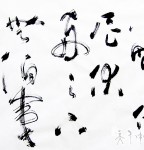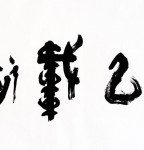Simon Leys admits [NYR, April 18] that he hasn’t understood the central chapters of The Chinese Art of Writing and that this “disqualifies [him] from writing a fair, comprehensive review” of it. He could have stopped there. He prefers instead to suggest that if he was baffled, it was because those chapters are unintelligible, their style abstruse.
To convince the reader of this, he cites a few lines which, presented in this way—without reference to the subject, to the context, or the thesis which forms the core of the book—are indeed difficult to understand. He could have served your readers better if he had simply referred to the introduction, where, I believe, each chapter is clearly summarized, particularly since the work, no longer available in English, “may prove to be a work of major significance”—if one is to believe Simon Leys himself. But does he believe what he writes? What does he truly think?
My uncertainty on this point would be a minor concern if, after having spent three quarters of his review writing in his own way about calligraphy, Simon Leys did not mention the “abundant inspiration” he has drawn from my book. In fact, on a number of points, without saying it, perhaps without perceiving it himself, he affirms the opposite of what I have written. He describes for instance Chinese writing as an “emblematic metalanguage” which “developed independently of contemporary speech” and in the end “generated a monosyllabic and non-inflected language” etc. “As Billeter argues,” he concludes, “there was a unique anteriority of script over speech.” But I never suggested anything of the sort.
My principal regret is that his argument with regard to calligraphy is, in essence, contrary to the spirit of my book. As others have done before him, he exaggerates the technical difficulties of the brush (because of a “diabolic difficulty of handling,” he writes, “long years of intensive training are required to reach a minimum level of competence”), he attaches too great a significance to the mystery of calligraphic art (“a key to supreme enlightenment”) and generally magnifies the distance which separates us from the world of the Chinese (“they stand at the antipodes of human experiment”). For my part, I sought to demonstrate that our own aesthetic experience (notably with music) contains virtually all that is necessary to understand Chinese calligraphy and that we can move beyond the limits of our world to enter that of the Chinese calligraphers. I tried to show that the study of their art can also lead us to a richer apprehension of our own experiences, to a deeper and perhaps different understanding.
On this point Simon Leys appears to me most intellectually conservative. “Beware of all thoughts that require new concepts,” he writes paraphrasing Thoreau. But he notes also that “China poses a permanent challenge to various notions which we naively assume to have universal validity.” He even affirms at the start of his review that “the discovery of a new major art should have more momentous implications for mankind than the exploration of an unknown continent.” Could he not admit that to make such a discovery, we may have to revise some of our traditional ideas, even shape new ones, and that this enterprise might at times deserve some effort? Curiously, he reproaches me for putting forward ideas which have no equivalent in the critical writing of Chinese calligraphers themselves. But that is precisely because these concepts are meant to serve as common denominators between their thinking and our own.
Simon Leys appears to be conservative in another way as well. He writes eloquently of the depth and refinement of traditional Chinese culture but, to my sight, he adopts—without meaning to—the same idealizing discourse which imperial literati applied to that culture, or more exactly to their culture. For my part, I have tried to free myself from this conventional discourse and one of the weaknesses of my book is, without doubt, that I have only imperfectly succeeded in doing so. On the other hand, Simon Leys continues to remind us of the ignorance of Westerners during the colonial period with regard to things Chinese. But we have moved beyond that point. Our task today is to achieve insight, and, if necessary, to innovate intellectually to achieve it. It is to create new means of communication between the Chinese of today and ourselves on essential questions. There was perhaps once a time when the ultimate ambition of a Sinologist was “to write a few good footnotes,” but that was in the nineteenth century.
Simon Leys has a knowledge of Chinese artistic traditions which Iknow to be deep, and which I admire, but there is between us an important difference in intellectual outlook which his review did not bring to light. It was this which I thought worth pointing out.
Jean François Billeter
University of Geneva
Geneva, Switzerland
Simon Leys replies:
J.F. Billeter and I are in fundamental agreement: since I did not understand the philosophical part of his book, and felt disqualified from writing a fair, comprehensive review of it, I should have stopped there, and presented instead my own, more orthodox view of Chinese calligraphy. Actually, this is exactly what I have done. If Istill made a number of references to his work—mostly to footnotes—this was essentially out of courtesy. On purely technical calligraphic grounds, one could have pointed out some of the weaker points of the book (as was done in a blistering review in Arts Asiatiques when the original edition of the book first appeared). But, knowing Billeter’s utter seriousness, as well as the amount of work and enthusiasm he had invested in this enterprise, I merely wished to acknowledge at least his considerable effort. I am sorry to see now that my friendly intention proved counterproductive. As regards footnotes:it is wrong to believe, as Billeter does, that this was a characteristic feature of nineteenth-century scholarship. On the contrary, nineteenth- century scholarship believed in monumental treatises, in supreme “scientific” answers, in ultimate syntheses, in final conclusions—which today make hilarious reading. If there is one thing that a Sinologist should have learned after a lifetime of study, it is precisely that some of the most creative Chinese thinkers chose, with good reason, to express their ideas by means of footnotes. This should come as no surprise to any perceptive mind. As Oliver Sacks once put it beautifully (he was commenting on his own passion for footnotes):”I do have a feeling that the more detail one can have the better….There is some safety in detail or in phenomena, and, on a higher plane, perhaps God is in the details?”
One last point: When J.F. Billeter blames me for being too conservative in my general understanding of China, is he alluding to the fact that, thirty years ago, I felt incapable of subscribing to his favorable assessment of Maoism and the “Cultural Revolution”? If this is the case, I shall gladly acknowledge my “conservatism”: after all, it is shared now by a large majority of the population of China.
| < Prev | Next > |
|---|
- 2011-01-09 - 从史籍无闻到“天下第一行书”——浅析唐太宗对《兰亭序》的“接受过程”
- 2010-12-30 - History of Chinese calligraphy : South North and Sui dynasty
- 2010-12-24 - Oracle Bones of Ancient ChinaOracle Bone Script
- 2010-12-23 - 论用笔与结字:书法艺术成熟的三大历史阶段
- 2010-12-23 - Cursive Script of Chinese Calligraphy
- 2010-08-27 - Introduction to Chinese Calligraphy
- 2010-01-18 - Modern Poetry in China : A Shimmering Window
- 2010-01-10 - 关于“请循其本”:古代书法创作研究国际学术讨论会的几点感想
- 2009-12-02 - 浅析书法演进理路
- 2009-11-03 - 浅谈书法的艺术神韵(转载)













